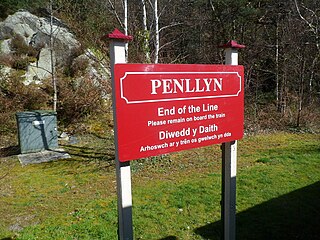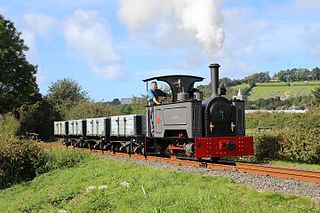
The Bala Lake Railway is a narrow-gauge railway along the southern shore of Bala Lake in Gwynedd, North Wales. The line, which is 4+1⁄2 miles (7.2 km) long, is built on a section of the former standard-gauge Ruabon–Barmouth GWR route that closed in 1965. Another section of the former permanent way is used by the Llangollen Railway. The Bala Lake Railway, which runs on 600 mm -gauge preserved rolling stock, is a member of the Great Little Trains of Wales.

The Brecon Mountain Railway is a 1 ft 11+3⁄4 in narrow gauge tourist railway on the south side of the Brecon Beacons in Wales. It climbs northwards from Pant along the full length of the Pontsticill Reservoir and continues past the adjoining Pentwyn Reservoir to Torpantau railway station. The railway's starting point at Pant is located two miles (3 km) north of the town centre of Merthyr Tydfil, Merthyr Tydfil County Borough, South-East Wales.

The National Slate Museum is located at Gilfach Ddu, the 19th-century workshops of the now disused Dinorwic quarry, within the Padarn Country Park, Llanberis, Gwynedd. The museum is dedicated to the preservation and display of relicts of the Slate industry in Wales.

The Padarn Railway was a narrow-gauge railway in North Wales, built to the unusual gauge of 4 ft. It carried slate seven miles (11 km) from Dinorwic Quarry to Port Dinorwic. The line opened on 3 March 1843, replacing the Dinorwic Railway. It initially used horses, but was converted to steam haulage on 23 November 1848. The railway was formally titled the Dinorwic Quarries Railway or Dinorwic Quarry Railway, but informally "Padarn Railway" was widely used.

The Llanberis Pass in Snowdonia carries the main road (A4086) from the south-east to Llanberis, over Pen-y-Pass, between the mountain ranges of the Glyderau and the Snowdon massif. At the bottom of the pass is the small village of Nant Peris.

Llyn Peris is a lake in Snowdonia, Wales, approximately 1.8 km long and situated close to the villages of Llanberis and Nant Peris, and the smaller twin of Llyn Padarn. The lake was formed glacially and is an example of a moraine-dammed lake. Llyn Peris is named after Saint Peris, an early Christian saint of whom little is known. The lake is flanked on one side by the mountain Elidir Fawr and the former slate quarry of Dinorwig. Above the opposite bank are the hills of Derlwyn and Clogwyn Mawr and a rock formation known as the Lady of Snowdon, due to its resemblance to a human face. The ruins of Dolbadarn Castle are also located on a mound above the lake.
The Dinorwic Railway was an early 2 ft narrow gauge industrial railway connecting the slate quarry at Dinorwic in Caernarvonshire with the coastal port at Y Felinheli. The line is sometimes referred to as the Dinorwic Tramroad or the Dinorwic Tramway.

Dinorwic quarry is a large former slate quarry, now home to the Welsh National Slate Museum, located between the villages of Llanberis and Dinorwig in Wales. At its height at the start of the 20th century, it was the second largest slate quarry in Wales, after the neighbouring Penrhyn quarry near Bethesda. Dinorwic covered 700 acres (283 ha) consisting of two main quarry sections with 20 galleries in each. Extensive internal tramway systems connected the quarries using inclines to transport slate between galleries. Since its closure in 1969, the quarry has become the site of the National Slate Museum, a regular film location, and an extreme rock climbing destination.

The Eigiau Tramway might refer to the Eigiau Quarry Tramway or to the Eigiau Reservoir Tramway.

The Cowlyd Tramway was a 2 ft narrow gauge railway line used to convey men and materials to Llyn Cowlyd Reservoir, near Trefriw in northern Wales during the enlargement of the dam, and thereafter for maintenance purposes.
The Cedryn Quarry Tramway was an industrial narrow gauge railway that connected the slate quarries at Cedryn and Cwm Eigiau to the quays at Dolgarrog in the Conwy valley.

Fire Queen is an early steam locomotive built by A. Horlock and Co in 1848 for the Padarn Railway. It is the only surviving locomotive from that railway, and it is preserved at the Vale of Rheidol Railway.

The Dinorwic Alice Class is a class of eleven narrow-gauge 0-4-0ST steam locomotives built specifically for the Dinorwic quarry. These locomotives were built by the Hunslet Engine Company between 1886 and 1904, and were designed and supplied specifically to work the many galleries of the quarry at Llanberis, North Wales.

Maid Marian is a preserved narrow-gauge steam locomotive built in 1903, currently based at the Bala Lake Railway in North Wales.

Llanberis (LLR) railway station is the southern terminus of the Llanberis Lake Railway (LLR), located in Llanberis, Gwynedd, Wales. The line and station primarily serve tourists and railway enthusiasts.

Gilfach Ddu (LLR) railway station is an intermediate station on the Llanberis Lake Railway (LLR), located in Llanberis, Gwynedd, Wales.

Cei Llydan is an intermediate railway station on the Llanberis Lake Railway (LLR), located in Llanberis, Gwynedd, Wales.

Penllyn (LLR) railway station is the northern terminus of the Llanberis Lake Railway (LLR), located near Llanberis, Gwynedd, Wales. The station has no platform, but passengers are allowed to alight.

Diana is a narrow gauge 0-4-0T steam locomotive. It was built by Kerr, Stuart and Company in 1909, and was delivered to the Kerry Tramway in Mid Wales, in 1917. After varied service in the Welsh slate industry, Diana was purchased by railway enthusiast Graham Mullis in 1964. After many years at a variety of location, Diana was purchased by a Talyllyn Railway volunteer in 2014, and restored to working order in 2015.

Gilfach Ddu are a series of well-preserved Grade I listed industrial buildings built to serve the Dinorwic slate quarry near Llanberis in Caernarfonshire, North Wales. The workshops compreise a complex of repair and maintenance buildings, that were built in 1870 to build and maintain the machinery used in the quarry. The complex includes saw sheds, patternmaking shops, a foundry with cupola, blacksmiths shops, fitting shops, stores, engine sheds, a canteen, the chief engineer's house, a hand operated crane and two waterwheels which provided the site with its power. Since 1972, the buildings have housed the National Slate Museum.






























